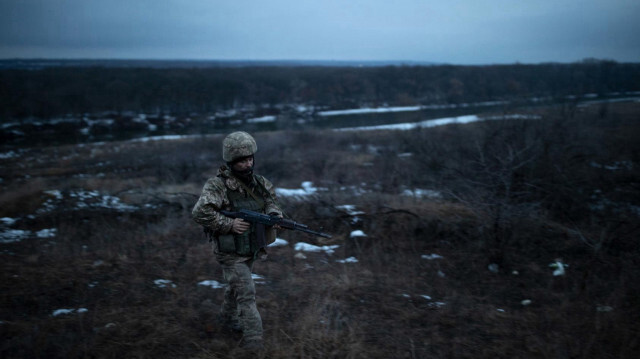

File photo
The ability of Ukraine to integrate new aid into its existing defense strategies will be crucial in determining its success on the battlefield
The protracted conflict between Ukraine and Russia has entered a critical phase, with recent developments on the ground shaping the course of events. As casualties mount and strategies evolve, it's imperative to examine the current situation and what lies ahead.
- Russian forces continue to inch forward in Ukraine's east
The Ukrainian army is grappling with intensified Russian offensives, particularly in the Donetsk region, ahead of the autumn mud season. This surge, highlighted by the fall of Avdiivka and the use of massive 3-ton FAB glide bombs, signals Russia's renewed military push. Russian forces are executing pincer movements to encircle Ukrainian units, aiming to sever key supply routes to Vuhledar, Chasiv Yar, and Toretsk.
Capturing Chasiv Yar, with its strategic elevation, would provide Russia with a vantage point over the plains leading to Sloviansk and Kramatorsk, crucial to Ukraine's defense in Donetsk. While the front lines remain largely static, Moscow's forces are making incremental gains, further straining Ukraine's defenses.
Despite the ongoing stalemate, Moscow's forces have made slow but steady gains, adding pressure on Ukraine's already strained defenses. Russia's strategy includes cutting off Ukrainian supply lines, a tactic that, if successful, could cripple Ukraine's ability to sustain its front-line positions.
- Ukraine's resilience amid a shifting battlefield
Despite enduring a grueling war of attrition, Ukraine has shown resilience by holding key fronts. Its most notable achievements lie in deep strikes within Russian and occupied territories, targeting energy infrastructure. These strategic attacks mark a new phase in Ukraine's military approach. However, the effectiveness of this strategy hinges on the readiness of Ukrainian soldiers. Ukrainian President Volodymyr Zelensky's admission [1] that only 2 out of 16 brigades are combat-ready raises concerns about the timely arrival and sufficiency of Western supplies.
Ukraine's ability to adapt its military strategy has been crucial in maintaining its defense against Russian advances. The focus on disrupting Russian supply lines and targeting critical infrastructure highlights Ukraine's tactical evolution. However, this approach requires sustained support from Western allies, particularly in terms of advanced weaponry and logistical support.
- Significance of Western military assistance
The United States (US) Congress had not approved large-scale funding for Kyiv for nearly a year and a half when Ukraine desperately needed it. If the West had provided this aid in a unified and forceful manner much earlier, a different scenario might have been playing out. Advanced weapons such as anti-aircraft systems, artillery, and fighter jets could have enhanced Ukraine's defensive capabilities and improved its ability to launch counterattacks. Over time, however, Russia has learned from its early mistakes, emphasizing logistical support to strengthen its front lines.
The delivery of the long-awaited F-16s and the new $1.7 billion aid package announced by the US for air defense munitions and artillery rounds were the two most important developments of the past week. These developments are crucial for bolstering Ukraine's defenses against Russian strikes and could alter the dynamics on the battlefield.
The new aid continues to give Ukraine a lifeline, even if it is not enough. The effectiveness of this assistance depends on several factors: timely delivery, proper training for Ukrainian forces, and integration into existing military strategies. It will also test the political will of Western countries to continue their support in the face of possible Russian retaliatory measures.
Ukraine hopes that the F-16s will enhance its ability to protect against Russian bombardment and provide a much-needed boost to its air defense capabilities. The arrival of these jets, albeit delayed, underscores the challenges Kyiv faces in securing timely and adequate support from its allies. The question remains whether these measures will be sufficient to turn the tide in Ukraine's favor.
- A crucial turning point
Ukraine is acutely aware that relying solely on external aid is insufficient. The arrival of the first 10 F-16s, [2] offers a much-needed boost as Ukrainian forces struggle to counter recent Russian advances. Kyiv's hope lies in these jets, which provide enhanced protection against relentless Russian bombardment. Yet, critical questions remain, can Ukraine train enough capable pilots, and can it safeguard these valuable assets against Russian attacks? The answers to these questions will shape the future of the conflict and the resilience of Ukraine's defense.
The ongoing conflict underscores the importance of sustained and strategic support from Western allies. The ability of Ukraine to integrate new aid into its existing defense strategies will be crucial in determining its success on the battlefield. As the international community watches closely, the outcomes of these efforts will have far-reaching implications for the broader geopolitical landscape.
[1] https://www.lemonde.fr/en/international/article/2024/07/31/volodymyr-zelensky-giving-up-ukrainian-territories-is-a-very-very-difficult-question_6706167_4.html
[2] https://www.economist.com/europe/2024/08/04/how-much-of-a-difference-will-ukraines-new-f-16s-make
*Opinions expressed in this article are the author's own and do not necessarily reflect the editorial policy of Anadolu.
#Donetsk
#Kyiv
#Moscow
#Russia
#Ukraine
#US
